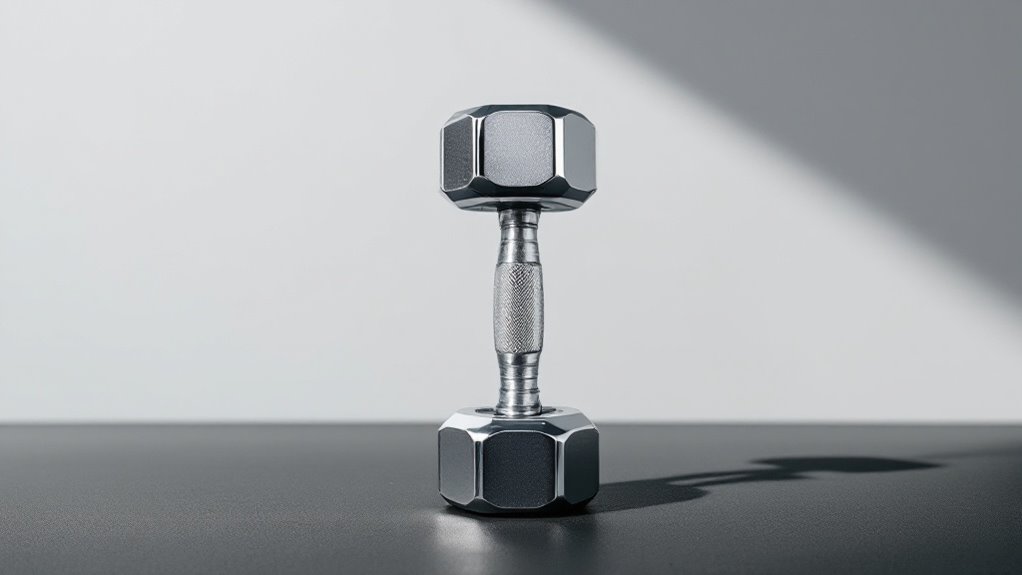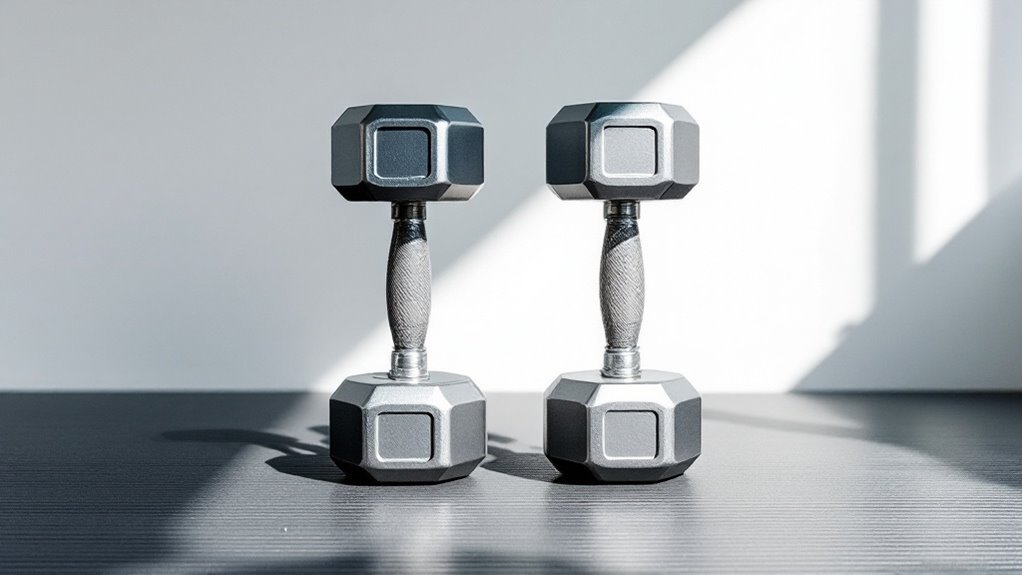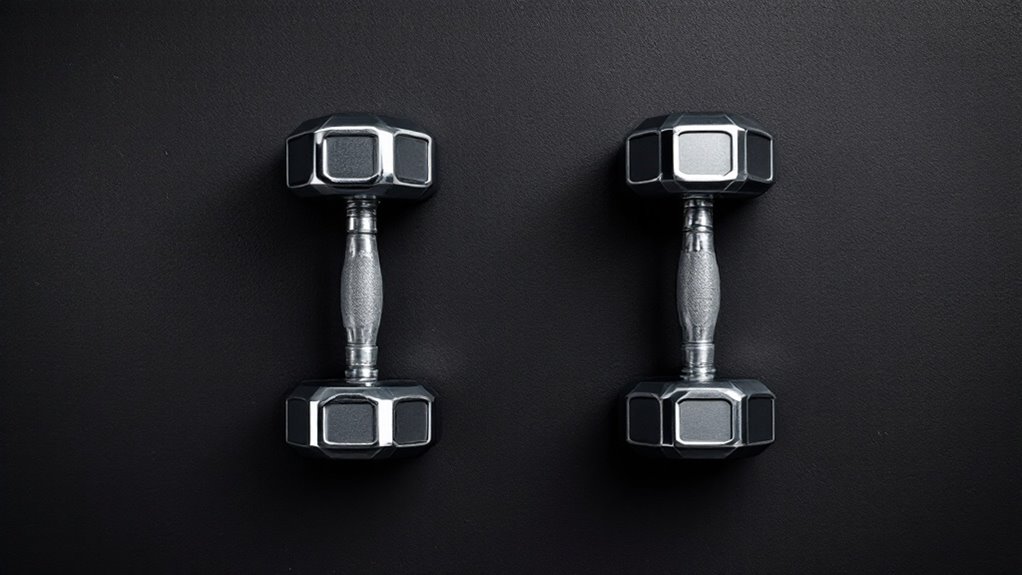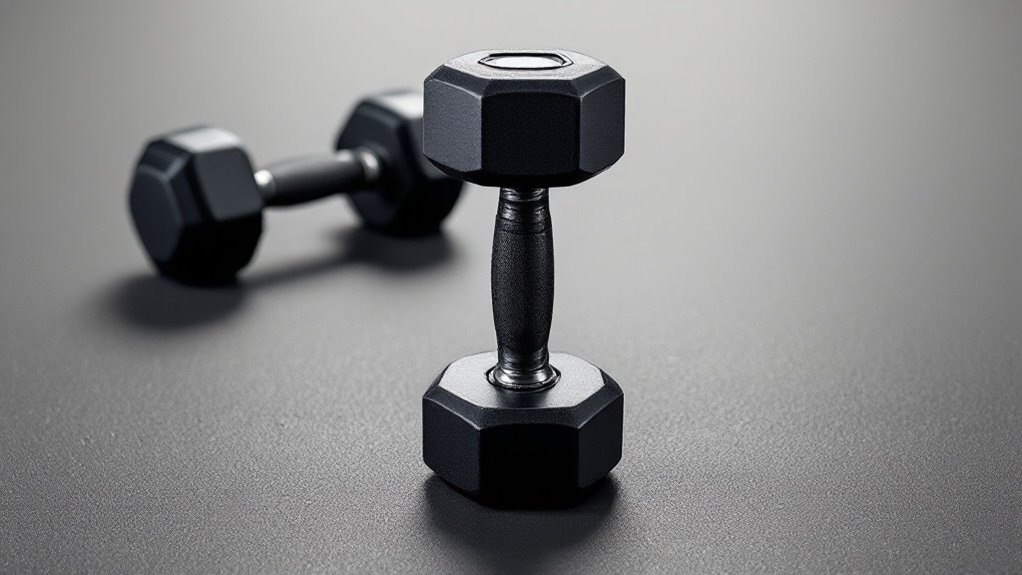Hammer Curls for Biceps

Hammer curls build bicep strength and mass while reducing wrist strain through a neutral grip position. This compound movement targets the brachialis, brachioradialis, and biceps brachii muscles simultaneously. Proper form requires shoulder-width stance, activated core, and controlled motion without swinging. For peak results, perform 2-3 times weekly with progressive overload principles. The exercise's versatility allows various grip positions and angles that reveal new dimensions of arm development.
Key Takeaways
- Hammer curls target multiple arm muscles including the brachialis, brachioradialis, and biceps brachii while reducing wrist strain.
- Stand with feet shoulder-width apart, palms facing each other, and curl weights up with controlled movement.
- Avoid swinging motions and maintain strict form by engaging your core and keeping shoulders back throughout the exercise.
- Perform hammer curls 2-3 times weekly, using progressive overload to build strength and muscle over time.
- Variations include alternating curls, cross-body curls, and seated incline curls to target biceps from different angles.
Proper Form and Technique

Mastering the hammer curl starts with perfect form – a fundamental technique that builds both strength and muscle definition in the biceps brachialis.
Stand with feet shoulder-width apart, gripping dumbbells at your sides with palms facing each other. Keep your core engaged and shoulders back.
Initiate the movement by curling the weights up toward your shoulders while maintaining a neutral grip. Your upper arms should remain fixed against your torso.
Control the descent, resisting gravity's pull. The key is maintaining strict form throughout – no swinging, no momentum. Each rep should be intentional and controlled, like a well-oiled machine executing its purpose.
For optimal muscle growth, aim to perform hammer curls 2-3 times weekly as part of your compound exercise routine to maximize overall bicep development.
Benefits and Targeted Muscles

With proper form established, the hammer curl reveals its true power as one of the most effective exercises for building impressive arms. The exercise uniquely targets the brachialis and brachioradialis muscles while engaging the biceps brachii, creating fuller, more developed arms. For women looking to enhance their upper body strength, hammer curls support progressive overload principles without causing excessive muscle bulk.
| Muscle Group | Primary Function | Development Impact |
|---|---|---|
| Brachialis | Elbow Flexion | Arm Thickness |
| Brachioradialis | Forearm Rotation | Forearm Size |
| Biceps Brachii | Supination | Peak Height |
| Grip Muscles | Hand Strength | Functional Power |
This compound movement improves grip strength and forearm development, essential for both aesthetic and functional fitness goals while reducing the risk of wrist strain compared to traditional curls.
Common Mistakes to Avoid

Three critical mistakes can derail the effectiveness of hammer curls and potentially lead to injury.
First, swinging the weights using momentum rather than controlled bicep engagement defeats the purpose of isolation. The body should remain stable throughout the movement.
Second, gripping the dumbbells too loosely compromises form and reduces muscle activation. A firm grip guarantees proper control and prevents the weights from moving during execution.
Third, rushing through repetitions with incomplete range of motion limits gains. Each rep should move through the full range, from full extension to peak contraction, with a intentional tempo that optimizes time under tension.
For optimal bicep development, integrate hammer curls into a compound exercise routine 3-4 times per week.
Variations and Programming Tips

Smart programming of hammer curl variations enables lifters to target the biceps from multiple angles while preventing plateaus.
By incorporating different variations strategically, athletes can optimize muscle growth and strength development.
Similar to bodyweight training programs, these exercises can be performed effectively at home with minimal equipment.
- Standing alternating hammer curls with controlled tempo: 3-4 sets of 8-12 reps, focusing on a 2-second eccentric phase
- Cross-body hammer curls: 3 sets of 12-15 reps per arm, emphasizing the brachialis muscle
- Seated incline hammer curls: 2-3 sets of 10-12 reps, maximizing peak contraction at the top
Program these variations across different training days, adjusting volume and intensity based on recovery capacity and overall training goals.
Frequently Asked Questions
Can Hammer Curls Make My Forearms Too Big?
While hammer curls do work the forearms, they typically won't cause excessive growth.
Forearm development depends largely on genetics, overall training volume, and nutrition.
For most people, hammer curls contribute to balanced, functional arm development. The movement actually helps create proportional arms by targeting both the biceps and forearms simultaneously, enhancing overall arm aesthetics rather than creating disproportionate growth.
Should I Do Hammer Curls Before or After Regular Bicep Curls?
Like a skilled conductor orchestrating a symphony, the order of arm exercises matters.
Traditional bicep curls should typically come first, as they target the primary bicep function. Hammer curls, which involve both biceps and forearms, are best performed afterward when the main bicep work is complete.
This sequence optimizes muscle recruitment and prevents early forearm fatigue from compromising the primary bicep workout.
Why Do Hammer Curls Feel Easier Than Traditional Bicep Curls?
Hammer curls typically feel easier because they involve the brachioradialis muscle along with the biceps, distributing the workload across more muscle groups.
The neutral grip position used in hammer curls is also more mechanically advantageous, placing less stress on the wrist joint.
Moreover, the brachialis muscle assists more during hammer curls, making the movement feel more natural and less taxing overall.
Can I Do Hammer Curls Every Day for Faster Results?
Training muscles every day might seem like a fast track to gains, but it's actually a recipe for disaster.
Muscles need 48-72 hours to recover and grow stronger. Daily hammer curls can lead to overtraining, increased injury risk, and stunted progress.
Instead, aim for 2-3 bicep workouts per week with proper rest days. This balanced approach yields better results and sustainable growth while preventing burnout and plateaus.
Are Hammer Curls Better With Dumbbells or Cables for Muscle Growth?
Both dumbbells and cables offer unique benefits for hammer curls.
Dumbbells provide better stabilization training and natural movement patterns, making them ideal for building foundational strength.
Cables maintain constant tension throughout the movement and offer varied resistance angles, potentially leading to better peak contractions.
For best results, incorporating both variations can enhance muscle growth by targeting different aspects of bicep development.
Final Thoughts
Hammer curls help build bigger, bolder biceps when performed with proper precision and persistence. This powerful pulling movement, properly programmed into training plans, produces peak performance and muscle growth. By mastering mechanics, maintaining momentum control, and mixing multiple variations, lifters can utilize this beneficial biceps builder for superior strength and size. Remember: regular, focused repetitions reward dedicated trainers with remarkable results.


